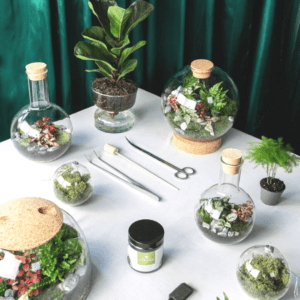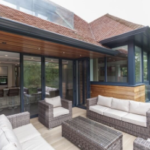
A Terrarium Workshop is a unique indoor eco-friendly miniature garden vessel that usually contains specific types of plants and soil. Terrariums or Terraria are one of the best gifts for people who have a green thumb and also for people who want to cultivate a green hobby in the comfort of their homes. Terrariums can not only be used as ornamental items at home but can also help adorn the inconsequential corners of a commercial establishment. Terrariums are sub-classified into two categories: –
- Closed Terrariums – Closed Terrariums are best suited for tropical plant species like mosses, ferns, orchids, and air plants which need a humid and sheltered environment resembling the tropical regions. However, Closed Terraria must be opened every once in a while, to remove excess moisture from the air and soil in the terrarium to avoid the growth of algae which otherwise, corrodes and harms the plant gradually while discoloring the walls of the terrarium
- Open Terrariums – Open Terraria is most suited for temperate plants because they require less humidity and less moisture in the soil. All plants that are adapted to dry climates and open environments, can’t survive the rich-in-moisture environment of closed terrariums therefore open terrariums are quite common and popular.
Making Terrariums is a quite interesting and intriguing activity without the need for fancy and expensive materials or equipment. An individual can make a simple terrarium within an hour with common containers like Fish Bowls and Glass vessels, even small glass jars! To make a basic terrarium, one must need the following items: –
- A Glass Container with/without a Lid.
- Activated Charcoal (Easily available at a Nursery, a Botanica, or a Pet Supply Store)
- Sterile Potting Mix
- Beach stones, Gravel.
- Decorative Elements (non-mandatory)
- Terrarium Plants (Temperate Plants for Open Terrariums, Tropical Plants for Closed Terrariums)
- Sheet Moss
- A Large Spoon or A Miniature Shovel.
Instructions: –
Step 1: The first and foremost step is to choose a clear glass container. Most people use open containers because they are less vulnerable to problems like condensation, growth of algae, and fungal plant diseases. Wider containers help us put more plants, gravel, stones, and décor elements like figures and shells into the terrarium.
Step 2: Now, select the best terrarium plants, i.e., mini plants which can be put inside your jar without touching the walls of the vessel. The most popular terrarium plants are: –
- East Indian Holly Fern
- Spiderwort
- Croton
- Golden Clubmoss
- Watermelon Peperomia
- Creeping fig
Step 3: Adding drainage layers – We must fill the bottom of the jar with a thick layer of stones instead of sheet moss to create a drainage system, preventing the plants’ roots from soaking extra water. Now cover the stones with a ½ inch layer of activated charcoal to control unnecessary odors and drainage.
Step 4: Add moss and potting soil for the plants which will also serve as a visual treat because of the color variation between layers.
Step 5: Preparing and Planting – Remove the plants from their pots through root pruning and plant them carefully inside the jar.
Step 6: Garnishing the terrarium – Customise the terrarium with decorative items. Place shells, figures, and ornaments delicately in the terrarium.




